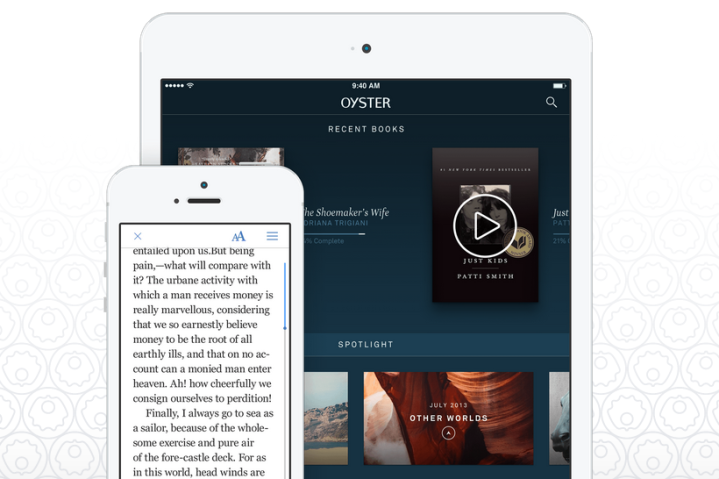
If you’re like Andrew and like to fill your shelves with many leather-bound books to impress your friends, digital books are probably a tough sell. But for fervent readers who just consume as much text as possible, Oyster could be a viable option for the price of less than a book a month. The team behind Oyster knows the difficulty of putting down the hard copy in exchange for your iOS device, and it isn’t out to kill off the bookstore, just provide the best reading experience tablet and phone users have ever had. In that regard, the app hits its mark.

The actual reading experience through most ebook reader apps is pretty identical, save for a few bells and whistles. You’ve got text on the screen with some ability to tweak the size and font. Oyster isn’t looking to reinvent what Amazon’s Kindle already made popular because there’s not a whole lot of places to go with it, but it has managed to take some of the strain out of reading from the screen. The ability to apply Instagram-esque filters over the page and modify the appearance of text, including an always-welcome night mode, makes it easy to find a display style that is easy on the eyes and makes for a pleasant reading experience, even over an extended period.
“It’s a unique offering and we’ve taken extra steps to build our product as the best all-in-one reading experience around … Our goal is to bring a clean, intuitive and sophisticated experience to users and we’ve heard incredible praise from our users already,” explained Van Lancker.

Reading is only half of what Oyster does. You’ll spend an equal amount of time searching for things to read thanks to the app’s 100,000+ book to selection. It’s a huge library by numbers alone, but not necessarily all that comprehensive given the amount of books published every year from publishers big to small. Amazon’s Kindle store, for example, has millions of books. Much like Netflix with movies and TV, Oyster will never have all the books available to subscribers, but it has a solid foundation and plenty more offerings on the way.
“Being New York based, we’ve had the opportunity to grow really strong relationships and onboard large, mid-size and smaller publishing houses,” said Van Lancker. “On Oyster, a title is valued by it’s quality and relevance to the reader and we’ve built a system, both editorial and algorithmic, that gives any size publishers a great way to get their books in front of more readers.”
Though there is currently no self-published presence on Oyster – and if you’ve browsed the Amazon marketplace for authors that have skipped the publishing (and in some cases, the editing) process, you may have an idea why – but Van Lancker did explain his company has “a few aggregators on board including Smashwords.”

Van Lancker claims, “By providing a single, common library at the core of Oyster, we’re able to create a focused community for our users to share and experience an incredible selection of books together. As the service grows and as reader’s habits and preferences are learned, the recommendations will become more personalized.”
Given the Netflix comparisons Oyster draws and the widely varied sub-genres of literature, we expected some extremely specific categories to appear from the suggestions. This wasn’t always the case, and sometimes it seemed as the the title held a little more weight than it should when generating recommendations, but for the most part the app was able to point us toward books that fit well into a niche we showed interest in.
As far as reading on iPhone and iPad go, the experience doesn’t get much better than Oyster. A monthly fee of $10, less than the price of one book in most cases, will provide a great value to those that find themselves flipping digital pages often. The service and its suggestion engine is already sharp, and it appears this will only get better as it grows. How Oyster expands will be the determining factor in its longevity. Some stronger social features – including direct recommendations from friends or shared reading lists – would be welcome and expansion into other platforms will give Oyster even more value. Being able to switch from your iPhone to an Android tablet and even pull up pages on your desktop without losing your spot would make the monthly price tag a no brainer.
Van Lancker stated Oyster has no “specific timing to share for when we’ll be available on other platforms,” but promised that he and his team are “dedicated to providing the best user experience possible on each device we roll-out.” Given what we see in the iOS app, we have no reason to doubt him.
You can download Oyster for free from the iTunes App Store here. The service costs $10 a month, but you can sign up for a free one month trial.
Editors' Recommendations
- Are you having iPhone alarm problems? A fix is coming soon
- How to undo reposts on TikTok (and why you should)
- How to schedule a text message on your iPhone
- An Apple insider just revealed how iOS 18’s AI features will work
- 5 phones you should buy instead of the iPhone 15


